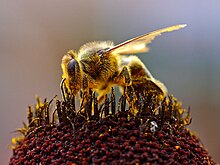زنبور عسل اروپایی
ظاهر
| زنبور عسل اروپایی | |
|---|---|

| |
| در حال جمع آوری گرده گل | |
| وضعیت حفاظت | |
| ردهبندی علمی | |
| فرمانرو: | جانوران |
| شاخه: | بندپایان |
| رده: | حشرات |
| راسته: | پردهبالان |
| تیره: | زنبوران عسل |
| سرده: | زنبور عسل |
| گونه: | زنبور عسل اروپایی |
| نام دوبخشی | |
| Apis mellifera کارل لینه, ۱۷۵۸
| |
| زیرگونهها | |
|
شمال غربی اروپا جنوب غربی اروپا
| |
| مترادف | |
| |
زنبور عسل اروپایی، زنبور عسل معمولی یا زنبور عسل غربی (نام علمی: Apis mellifera) رایجترین گونه از ۷ تا ۱۲ گونه زنبور عسل در سراسر جهان است.[۱][۲] این گونه خاستگاهش سرزمینهای بر قدیم است ولی در آغاز قرن هفدهم میلادی به بر جدید هم منتقل شد. این گونه در سال ۱۷۵۸ (میلادی) توصیف شد.
نگارخانه[ویرایش]
-
زنبور عسل اروپایی
-
عسل اروپایی
-
شفیره
جستارهای وابسته[ویرایش]
منابع[ویرایش]
- ↑ Michael S. Engel (1999). "The taxonomy of recent and fossil honey bees (Hymenoptera: Apidae: Apis)". Journal of Hymenoptera Research. 8: 165–196.
- ↑ Lo, N.; Golag, R.S.; Anderson, D.L.; Oldroyd, B.P. (2010). "A molecular phylogeny of the genus Apis suggests that the Giant Honey Bee of the Philippines, A. breviligula Maa, and the Plains Honey Bee of southern India, A. indica Fabricius, are valid species". Systematic Entomology. 35 (2): 226–233. doi:10.1111/j.1365-3113.2009.00504.x. S2CID 84531938.
در ویکیانبار پروندههایی دربارهٔ زنبور عسل اروپایی موجود است.
- Beediseases Honey bee diseases website by Dr. Guido Cordoni.
- Flight of Honey Bee finally understood بایگانیشده در ۱۶ مه ۲۰۰۸ توسط Wayback Machine
- Honey Bee Pheromones
- Cornwall Honey Beepedia
- BeeSource
- Honey Bee Apis mellifera diagnostic pictures, descriptions, natural history
- Brother Adams On-line book
- Beekeeping explained by the فائو
- Types of hives by FAO[پیوند مرده]
- Interactive 3D flash presentation of Honey beehive from PBS
- Brainy Bees Think Abstractly
- Digital library of Beekeeping
- Anatomy of the honeybee by the FAO
- Apis mellifera pomonella, a new honey bee subspecies from Central Asia; Apidologie 34 (2003) 367-375; Sheppard and Meixner[پیوند مرده]
- Origin of honeybees from the Yucatan peninsula inferred from mitochondrial DNA analysis; Molecular Ecology (2001)10, 1347-1355
- Cyclopedia of American Agriculture ed. by L. H. Bailey (1911), Vol. III—Animals, "Bees," including a history of the literature related to European honey bees in the United States.
- Apis mellifera on the دانشگاه فلوریدا / IFAS Featured Creatures website.
کتابشناسی[ویرایش]
- A. I. Root's The ABC and XYZ of Beekeeping
- Molecular confirmation of a fourth lineage in honeybees from the Near East Apidologie 31 (2000) 167-180, accessed Oct 2005
- Biesmeijer, Jacobus. "The Occurrence and Context of the Shaking Signal in Honey Bees (Apis mellifera) Exploiting Natural Food Sources". کردارشناسی. ۲۰۰۳.
- Collet, T. , Ferreira, K.M. , Arias, M.C. , Soares, A.E.E. and Del Lama, M.A. (2006). Genetic structure of Africanized honeybee populations (Apis mellifera L.) from Brazil and Uruguay viewed through mitochondrial DNA COI–COII patterns. Heredity 97, 329–335.
ردهها:
- فهرست سرخ IUCN از گونههای کمبود داده
- زنبور عسل اروپایی
- آرایه (زیستشناسی) نامگذاریشده توسط کارل لینه
- پردهبالان آسیا
- پردهبالان آفریقا
- پردهبالان اروپا
- پردهبالان نیوزیلند
- جانوران شهری
- حشرات توصیفشده در ۱۷۵۸ (میلادی)
- حشرات خاورمیانه
- حشرات شمال آفریقا
- گیاهان و گردهافشانها
- نمادهای جورجیا
- نمادهای داکوتای جنوبی
- نمادهای ورمانت
- نمادهای ویرجینیای غربی
- نمادهای ویسکانسین
- نمادهای یوتا
- نمادهای کنتاکی
- نمادهای ایالت میسیسیپی




